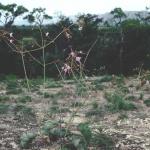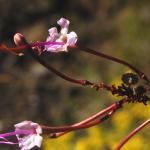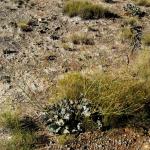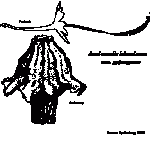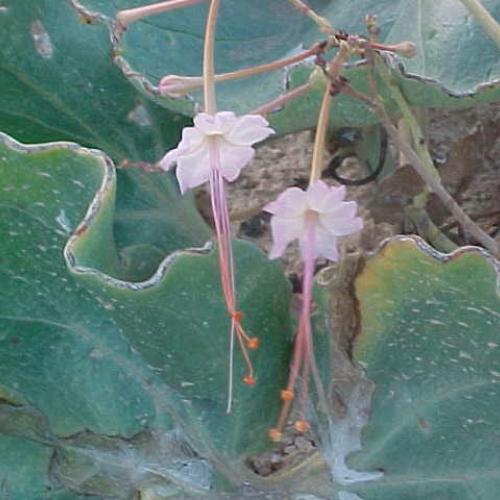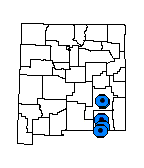Anulocaulis leiosolenus var. gypsogenus (Gypsogenus Ringstem)
ANULOCAULIS GYPSOGENUS WATERFALL
Robust perennial herb to 1.5 m tall, forming large clumps; leaves mostly in 1-3 pairs in the basal 1/4 of the plant, petioles 5-10 cm long, blades broadly ovate to more or less circular, thick, leathery-succulent, glaucous pale bluish-green, smooth; inflorescence widely paniculate, forming the distal 3/4 of the plant, the internodes with sticky glutinous bands; flowers borne singly or in few-flowered clusters; perianth funnelform, 5-lobed, slightly zygomorphic, white to very pale pink, about 3 cm long; stamens 3, about twice the length of the perianth, lavender-pink; style exserted slightly beyond the anthers, lavender-pink; fruit biturbinate, 5-8 mm long, 3-4.5 mm wide, with 10 irregular longitudinal ridges and with an equatorial wing 0.8-1.2 mm wide. Flowers June to October.
Anulocaulis leiosolenus var. howardii, from the west slope of the Guadalupe Mountains, differs in its somewhat glaucous bluish-green leaves with scattered darkened tubercules, its deep rose-pink flowers, and the fruit with a wing 0.2-0.9 mm wide. Anulocaulis leiosolenus var. leiosolenus, mostly from along the Rio Grande, has green leaves that are notably tuberculate, pale pink flowers, and a wing on the fruit 0.2-0.6 mm wide.
New Mexico, Chaves and Eddy counties, along the drainage of the Pecos River; adjacent Texas, Culberson, Loving, and Reeves counties.
Open gypsum outcrops at about 1,000-1,400 m (3,300-4,600 ft).
This plant does not occur off gypsum, but is locally abundant within its restricted habitat. Dropped in 2017 (not rare).
Pecos gyp ringstem is common within its habitat. Plants are occasionally browsed by domestic livestock as they pass through populations.
*Spellenberg, R. 1993. Taxonomy of Anulocaulis (Nyctaginaceae). Sida 15:373-389.
Spellenberg, R. and T. Wootten. 1999. Vascular plants on a gypsum outcrop in southern New Mexico: A listing, a new variety and taxonomic realignments in the Anulocaulis leiosolenus complex (Nyctaginaceae), and a new variety of Mentzelia humilus (Loasaceae). Sida 18(4):987-999.
For distribution maps and more information, visit Natural Heritage New Mexico


